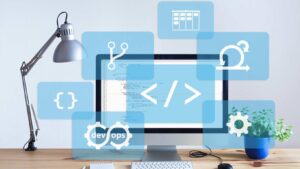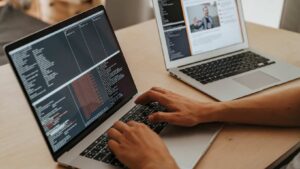 UX design, also known as User Interface design (UI), focuses on improving usability and accessibility with the goal of improving customer satisfaction. Unlike UI design, which focuses on appearance, UX design goes into the overall feel of the app.
Just like a well-organized store with friendly staff encourages customers to stay and make purchases, a well-designed UX in apps boosts user loyalty, engagement, and satisfaction, ultimately contributing to app success.
UX design, also known as User Interface design (UI), focuses on improving usability and accessibility with the goal of improving customer satisfaction. Unlike UI design, which focuses on appearance, UX design goes into the overall feel of the app.
Just like a well-organized store with friendly staff encourages customers to stay and make purchases, a well-designed UX in apps boosts user loyalty, engagement, and satisfaction, ultimately contributing to app success.
Impact of UX Design on App Success
- User Retention and Engagement: A seamless user experience is critical for retaining users and fostering engagement. Research by Forrester reveals that a well-designed user interface could raise website conversion rates by up to 200%, and a better UX design could yield conversion rates up to 400%.
- Customer Satisfaction and Loyalty: Customer satisfaction is the cornerstone of brand loyalty. A study by Google found that 52% of users are less likely to engage with a company due to poor mobile app user experience design, demonstrating the significant impact of mobile UX design on user perceptions and behaviors.
- Positive Brand Image and Reputation: A well-crafted UX reflects positively on the brand, conveying professionalism, reliability, and trustworthiness. Consistently delivering exceptional experiences fosters a positive brand image and strengthens the reputation of the app.
- Increased Revenue and ROI: The financial implications of UX design cannot be overstated. A study by Forrester indicates that every dollar invested in UX brings in between $2 and $100 in return, illustrating the substantial ROI of prioritizing user experience in app development.
Key Principles of Effective UX Design
- User-Centered Design Approach: Understanding the needs, preferences, and behaviors of the target audience is paramount. UX design should be guided by concern, placing the user at the center of the design process.
- Consistency and Familiarity: Consistent design patterns and familiar interactions contribute to a seamless user experience. Users shouldn’t have to relearn how to use the app every time they interact with it.
- Simplicity and Intuitiveness: Complexity breeds frustration, while simplicity fosters usability. Research by the Baymard Institute found that the average documented online shopping cart abandonment rate is 70.19%, with complex checkout processes being a significant contributing factor. Simplifying the user journey can mitigate abandonment rates and improve conversion rates.
- Feedback and Iteration: Continuous improvement is essential for staying ahead of user expectations. According to a report by IBM, design thinking, an iterative approach to problem-solving, can reduce time to market by up to 75% and increase revenue by up to 300%.

UX Design Process
The UX design process follows a structured framework, encompassing several stages:
1. Research and Analysis: |
Understanding user needs, market trends, and competitors lays the foundation for effective UX design. Through comprehensive research, designers gain valuable insights to inform strategic decisions throughout the design process. |
2. Wireframing and Prototyping: |
Creating low-fidelity wireframes and interactive prototypes allows designers to visualize the app’s layout and flow. |
3. Testing and Iteration: |
Usability testing with real users identifies pain points and informs iterative improvements. |
4. Implementation and Evaluation: |
Collaborating with developers to implement design decisions and continuously evaluating the user experience post-launch ensures ongoing optimization. |
Examples of Successful UX Design in Apps
- Airbnb: By simplifying the booking process and providing personalized recommendations, Airbnb has transformed the travel industry. Airbnb has facilitated over 1 billion guest arrivals since its inception, highlighting its widespread adoption and success.
- Instagram: With its intuitive design application interface and seamless photo-sharing experience, Instagram has become a social media powerhouse. According to Statista, Instagram has over 1 billion active users, making it one of the most popular social media platforms globally.
- Spotify: Offering personalized music recommendations and curated playlists, Spotify has revolutionized the way people discover and enjoy music. Spotify has over 602 million users, reaffirming its position as a leader in the music streaming industry.
Challenges and Solutions in UX Design
- Designing for Different Platforms and Devices: Adapting the user experience to various devices and screen sizes poses a significant challenge. According to a study by Statista, mobile devices account for 54.67% of global website traffic in Q4 of 2023, highlighting the importance of responsive design in reaching mobile users.

- Addressing User Feedback and Evolving Needs: User needs and preferences evolve over time, requiring apps to adapt continuously. Regularly collecting and incorporating user feedback ensures that the app remains relevant and responsive to changing user expectations.
- Overcoming Budget and Resource Constraints: Limited budgets and resources can pose challenges for UX design projects. However, leveraging open-source tools and prioritizing features based on their impact on the user experience can help maximize the impact of available resources.
Frequently Asked Questions
Why is UX design important in app development?
UX design ensures that an app is user-friendly, intuitive, and provides a positive experience for users. A good UX design makes navigation easy, keeps users engaged, and ultimately leads to higher satisfaction and retention rates.
How does UX design impact app usability?
UX design directly affects usability by focusing on how users interact with the app. A well-designed app with a smooth and intuitive interface will be easier to navigate, helping users accomplish their goals efficiently without frustration.
What role does UX design play in user retention?
Good UX design leads to higher user retention by making the app enjoyable and easy to use. If users have a positive experience with the app, they are more likely to return and recommend it to others.
How does UX design help in reducing app abandonment?
UX design reduces app abandonment by addressing pain points that can frustrate users. By streamlining navigation, improving performance, and making the app visually appealing, users are less likely to abandon the app due to poor usability.
What is the difference between UX and UI design?
UX (User Experience) design focuses on the overall experience and how easy and enjoyable the app is to use, while UI (User Interface) design deals with the visual elements and layout that users interact with, like buttons and icons.
How can UX design contribute to a startup’s success?
For startups, UX design can be a competitive advantage by helping the app stand out. A well-designed app can attract users, encourage them to stay, and foster positive reviews, all of which contribute to business growth.
Why should UX be prioritized in the early stages of app development?
Prioritizing UX design early in app development ensures that the app meets user needs from the start. It helps identify user pain points, streamline workflows, and lay a strong foundation for a positive user experience.
How does UX design affect app performance?
UX design impacts app performance by optimizing the flow of interactions and reducing unnecessary steps. A streamlined design leads to faster load times, fewer errors, and a more responsive app.
What are some common UX design principles in app development?
Key UX design principles include simplicity, consistency, feedback, accessibility, and responsiveness. These principles ensure the app is intuitive, efficient, and enjoyable for all users.
How does UX design influence conversion rates?
A well-executed UX design can improve conversion rates by making it easier for users to navigate the app, find what they need, and take actions like signing up or making a purchase. Clear calls-to-action and a smooth user journey increase the likelihood of conversion.











